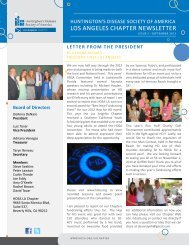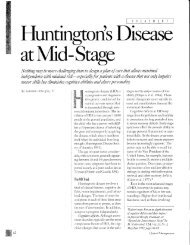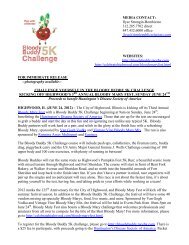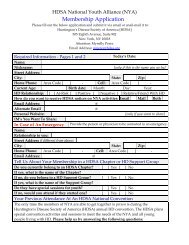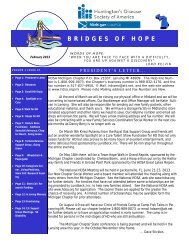Understanding Behavior in HD.final.8-18-05 - Huntington's Disease ...
Understanding Behavior in HD.final.8-18-05 - Huntington's Disease ...
Understanding Behavior in HD.final.8-18-05 - Huntington's Disease ...
Create successful ePaper yourself
Turn your PDF publications into a flip-book with our unique Google optimized e-Paper software.
5<br />
A bra<strong>in</strong> circuit is made of neurons that communicate with one another when they fire or “talk.” Neurons,<br />
which are microscopic, look like this:<br />
They “talk” via chemical substances called neurotransmitters to get <strong>in</strong>formation transferred <strong>in</strong> the bra<strong>in</strong><br />
like this:<br />
UNDERSTANDING THE ROLE OF THE CAUDATE IN THE BRAIN: THE CAUDATE GATE<br />
Given the numerous connections of the caudate with other areas of the bra<strong>in</strong>, it has a great deal of impact<br />
on behaviors. The caudate is one of many “gates” <strong>in</strong> the bra<strong>in</strong>. Gates are used to regulate, organize, and filter<br />
<strong>in</strong>formation. The caudate has been found to be a very important bra<strong>in</strong> gate because it has the most<br />
connections with the frontal lobes and it <strong>in</strong>fluences mood and cognition as well as motor skill. In general, the<br />
caudate regulates all <strong>in</strong>formation that passes through it, <strong>in</strong>clud<strong>in</strong>g movements, thoughts and feel<strong>in</strong>gs. When<br />
<strong>in</strong>formation that travels along the circuit arrives at the caudate, the caudate’s job is to “regulate” or “gate” the<br />
<strong>in</strong>formation before send<strong>in</strong>g it along to the next station.<br />
For many of our day-to-day behaviors, regulation is critical <strong>in</strong> determ<strong>in</strong><strong>in</strong>g whether the behavior will<br />
become a problem. For <strong>in</strong>stance, a little anger (often called annoyance) is acceptable, whereas a temper<br />
outburst is a problem. A little concern (often called worry) is normal, whereas non-stop repetition of a concern<br />
(often called obsession) can become a problem.<br />
Be<strong>in</strong>g from Iowa, I th<strong>in</strong>k of the caudate gate much like I th<strong>in</strong>k of the gates on our farm. The gate was our<br />
method of controll<strong>in</strong>g the cows. For example, when it was time to milk at the end of the day, the gate was<br />
opened wide, allow<strong>in</strong>g all of the cattle to cross the road and come <strong>in</strong>to the barn. When it was time to wean the<br />
calves from their mothers, the gate was opened and closed quickly, allow<strong>in</strong>g one calf at a time to come through<br />
the gate <strong>in</strong>to the neighbor<strong>in</strong>g paddock. At Fair time, we only wanted the prize heifer out, so we opened the<br />
gate only once to lead the w<strong>in</strong>n<strong>in</strong>g heifer to the Fair. The caudate is necessary to regulate <strong>in</strong>formation <strong>in</strong> the



